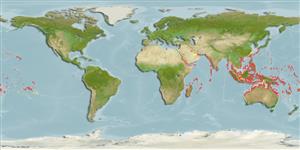分類 / Names
俗名 | 同種異名 | Catalog of Fishes(屬, 種) | ITIS | CoL | WoRMS | Cloffa
Teleostei >
Eupercaria/misc (Various families in series Eupercaria)
鱸形目 (Various families in series Eupercaria) >
Labridae (Wrasses)
隆頭魚科 (Wrasses) > Corinae
Etymology: Halichoeres: Greek, als, alis = salt + Greek, choiros = pig (Ref. 45335).
More on author: Rüppell.
Environment: milieu / climate zone / depth range / distribution range
生態學
海洋 礁區魚類; 深度上下限 0 - 30 m (Ref. 1602). 熱帶; 31°N - 33°S, 33°E - 124°W
Indo-Pacific: Red Sea south to Inhaca Island, Mozambique (Ref. 4392) and east to the Hawaiian (1 specimen) and Tuamoto islands, north to southern Japan, south to the southern Great Barrier Reef and Austral Islands.
印度-太平洋: 紅海南至英哈卡島, 莫三比克 (參考文獻 4392) 而且東至夏威夷 (1件標本) 與 Tuamoto 島, 北至日本南部, 南至大堡礁的南方與奧斯垂群島。
Length at first maturity / 大小 / 重量 / 年齡
Maturity: Lm 7.0 range ? - ? cm
Max length : 18.0 cm TL 雄魚/尚未辨別雌雄; (Ref. 4392)
背棘 (總數): 9; 背的軟條 (總數): 13-14; 臀棘 3; 臀鰭軟條: 12 - 13. Juveniles are black with numerous longitudinal white streaks (Ref. 1602).
稚魚是黑色的有很多的縱向白色的條紋.(參考文獻 1602)
Inhabit lagoon and seaward reefs, along the upper edges of coral-rich areas (Ref. 9710, 58534). Benthopelagic (Ref. 58302). May be solitary or found in small group (Ref. 90102). Juveniles are encountered in exposed outer reef flats (Ref. 1602). Feed on a wide variety of small invertebrates as well as fish eggs.
棲息於潟湖與臨海礁石, 沿著珊瑚豐富的區域的上緣.(參考文獻 9710,58534) 稚魚在裸露的外礁平臺被見到。 (參考文獻 1602) 捕食各式各樣的小型無脊椎動物以及魚卵。
Life cycle and mating behavior
成熟度 | 繁殖 | 產卵場 | 卵 | 孕卵數 | 仔魚
Pelagic spawner. Females migrate to spawning sites, larger females travel long distances to downcurrent areas than smaller ones to protect the eggs from becoming prey to larger reef fishes (Ref. 32198). Spawning sites are chosen by the females irregardless of the males occupying them (Ref. 32198). Females spawn in more than one spawning site, each site occupied by more than one male, which are either territorial or non-territorial (Ref. 32198). After spawning, they return individually to their home ranges without passing through other spawning sites (Ref. 32198). Some females on the other hand change sex after spawning (Ref. 32198). As males, they begin to establish territories in the spawning sites, even to those they visited before the sex change (Ref. 32198). This observation support the suggestion (Warner's 1985, 1986) that females stored information on spawning sites by migrating to various sites which aided in the acquisition of a mating territory after changing sex (Ref. 32198).印度-太平洋: 紅海南至英哈卡島, 莫三比克 (參考文獻 4392) 而且東至夏威夷 (1件標本) 與 Tuamoto 島, 北至日本南部, 南至大堡礁的南方與奧斯垂群島。
Randall, J.E., G.R. Allen and R.C. Steene, 1990. Fishes of the Great Barrier Reef and Coral Sea. University of Hawaii Press, Honolulu, Hawaii. 506 p. (Ref. 2334)
人類使用
漁業: 低經濟; 水族館: 商業性
更多資訊
參考文獻養殖養殖資訊品種遺傳學Electrophoreses遺傳率疾病加工NutrientsMass conversion
合作者照片Stamps, Coins Misc.聲音神經毒速度泳型鰓區Otoliths腦重體重比眼睛色素
工具
特別的報告
下載 XML
網路資源
Estimates based on models
Preferred temperature (Ref.
123201): 25 - 29.3, mean 28.3 °C (based on 3073 cells).
Phylogenetic diversity index (Ref.
82804): PD
50 = 0.5000 [Uniqueness, from 0.5 = low to 2.0 = high].
Bayesian length-weight: a=0.01047 (0.00607 - 0.01808), b=3.16 (3.01 - 3.31), in cm total length, based on LWR estimates for this species & Genus-body shape (Ref.
93245).
營養階層 (Ref.
69278): 3.2 ±0.2 se; based on diet studies.
Generation time: 1.5 ( na - na) years. Estimated as median ln(3)/K based on 1
growth studies.
回復力 (Ref.
120179): 高度, 族群倍增時間少於 15個月 (K=0.7).
Fishing Vulnerability (Ref.
59153): Low vulnerability (20 of 100).
Nutrients (Ref.
124155): Calcium = 89.3 [53.4, 149.2] mg/100g; Iron = 0.784 [0.460, 1.420] mg/100g; Protein = 18.5 [15.6, 20.7] %; Omega3 = 0.15 [0.10, 0.23] g/100g; Selenium = 27 [17, 48] μg/100g; VitaminA = 101 [33, 373] μg/100g; Zinc = 1.73 [1.21, 2.74] mg/100g (wet weight);
